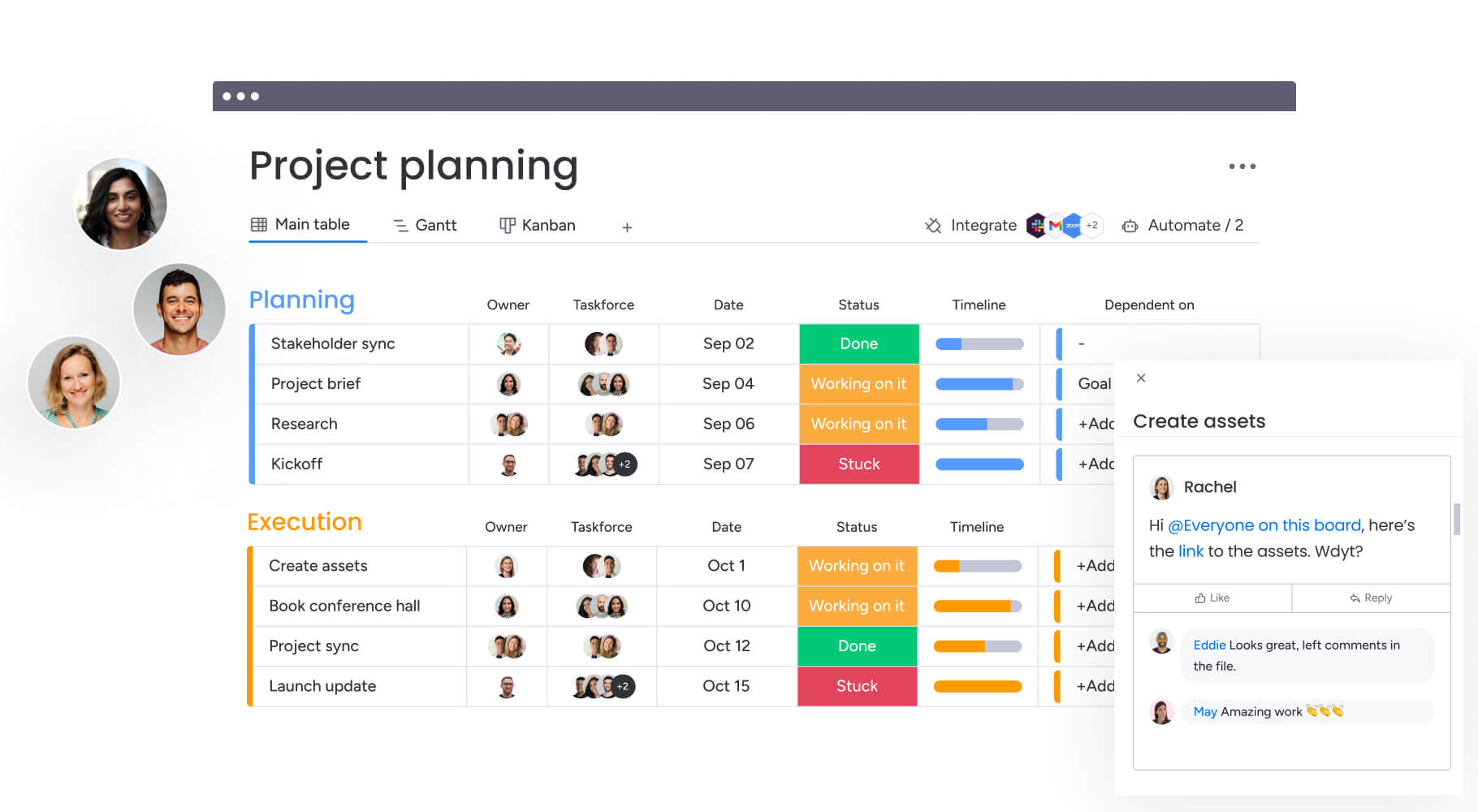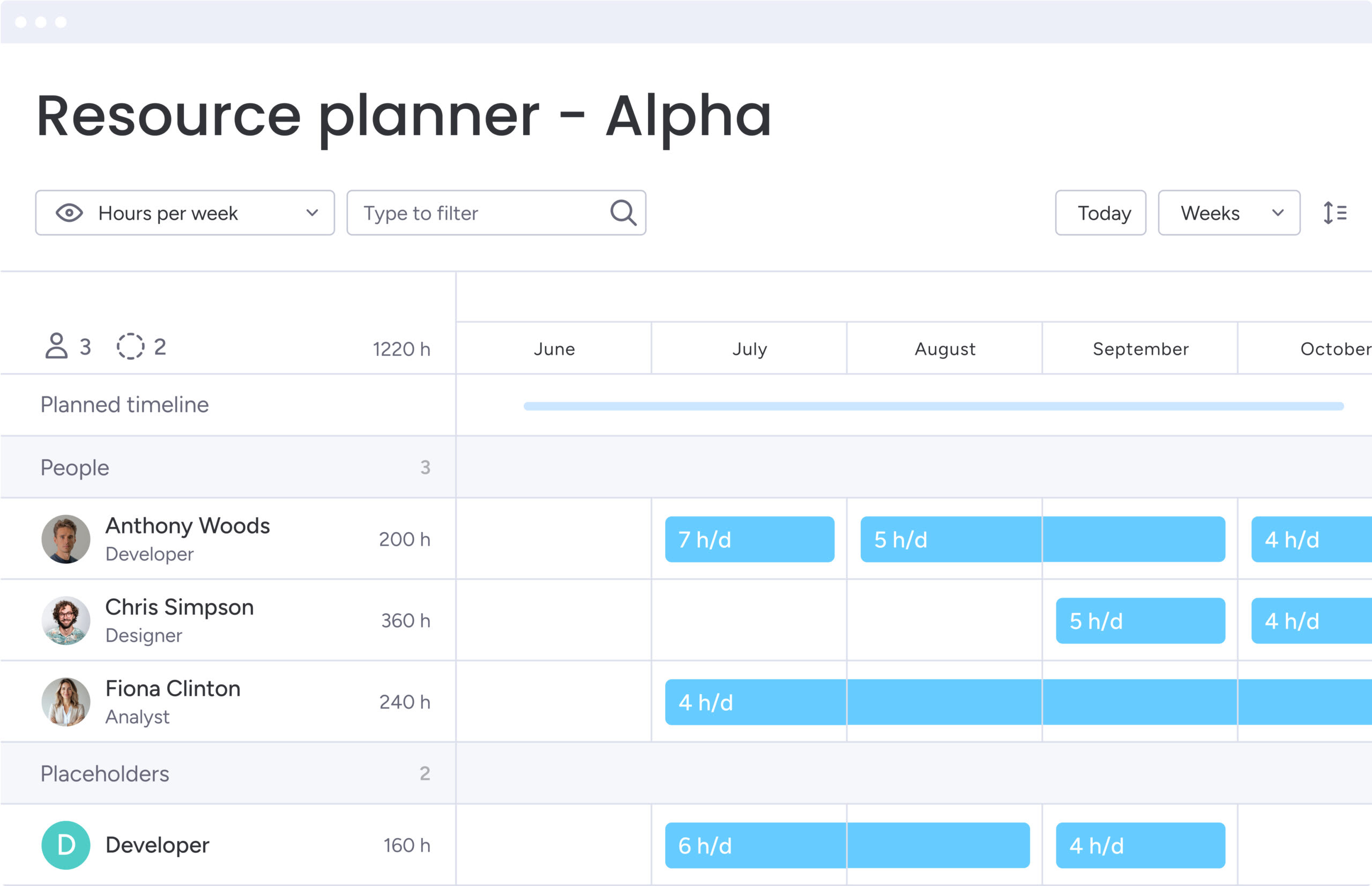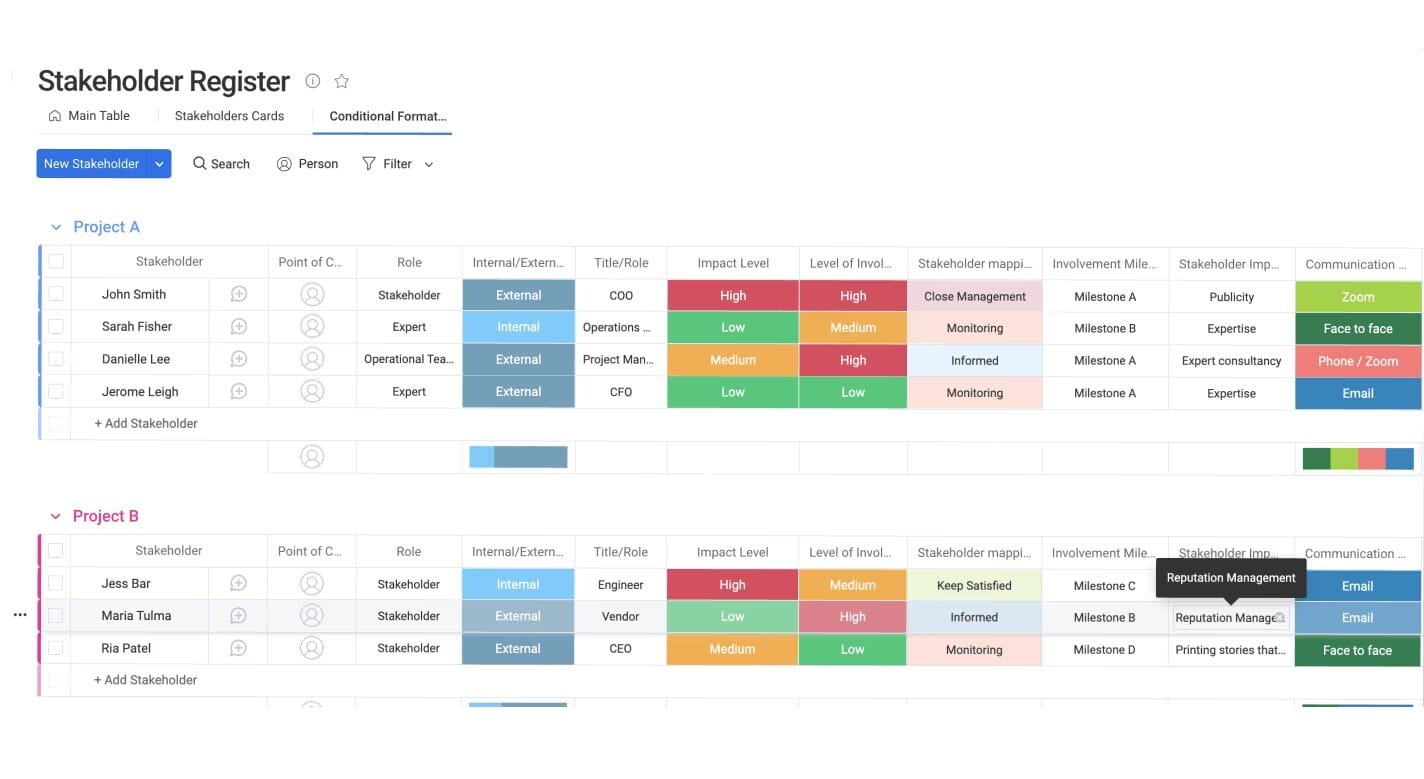A project’s success rarely depends solely on the project team. It hinges on a network of individuals and groups who provide funding, set requirements, and ultimately determine if the work delivers value.
Managing these relationships proactively prevents costly delays, defines scope precisely, and ensures the final deliverable meets real business needs. It transforms project management from a simple execution process into a strategic alignment effort.
In this article, we’ll walk through a systematic approach to stakeholder management, including how to identify stakeholders, analyze their influence using proven frameworks (and AI-powered suggestions), and create communication strategies tailored to their roles. You’ll learn how to build support and navigate complex relationships, turning potential obstacles into project champions.
Try monday work managementKey takeaways
- Project stakeholders include anyone who can affect or be affected by your project, including internal team members, executives, customers, vendors, and regulatory bodies who control resources and influence outcomes.
- Systematic stakeholder identification through brainstorming, document review, interviews, and organizational mapping ensures you don’t miss critical players who could derail your project later.
- Different stakeholder types require tailored engagement strategies based on their power and interest levels, from managing high-influence executives closely to keeping low-power supporters informed through regular updates.
- With monday work management, you can centralize stakeholder information and automate communications using custom dashboards and real-time updates — so every stakeholder receives relevant information, without project managers getting bogged down by manual reporting.
- Effective stakeholder management throughout the project lifecycle transforms difficult stakeholders into advocates who secure resources, remove obstacles, and support future initiatives beyond the current project. Leveraging AI insights means you can anticipate needs and concerns, further elevating your stakeholder relationships.

What are project stakeholders?
Project stakeholders are people or groups who can affect or be affected by your project, and engaging them is considered the most valuable PM process for ensuring success. This includes anyone with a vested interest in the project’s outcome — from the executive who approves your budget to the team using your final deliverable. AI now assists with mapping these relationships, analyzing communication patterns, and surfacing key influencers who might otherwise slip under the radar.
Think of stakeholders as the ecosystem around your project. They control resources, make decisions, and determine whether your project succeeds or fails. Artificial intelligence can continually monitor engagement signals, alerting you to changing dynamics or new potential risks among your stakeholder network.
Defining stakeholders in project management
In project management, stakeholders have specific characteristics that set them apart from general participants — they possess decision-making power, control resources, or significantly influence project outcomes. AI-driven analytics can help classify these roles faster and more accurately, drawing from organizational charts, communication data, and project documentation.
Here’s what makes someone a stakeholder:
- Influence: They can impact project decisions or change project direction.
- Interest: They care about project results because they affect their work or goals.
- Investment: They contribute resources like budget, time, or expertise.
Stakeholders vs project team members
All project team members are stakeholders, but not all stakeholders are team members. Team members execute daily work. Stakeholders might only provide approvals or requirements.
For example, in a software project, developers write code while the finance director approves the budget. Both are essential, but their involvement differs completely — and intelligent analytics can flag when one group’s engagement is slipping or when their input is needed most.
Looking for a stakeholder register template? Check this one out.
How project stakeholders can make or break your success
Every project is a dynamic ecosystem where success depends on more than schedules and task lists. Stakeholders are the hidden force behind every milestone, decision, and challenge — and here’s why:
- Control over resources and priorities: Stakeholders decide budgets, staffing, and timelines — choices that can accelerate progress or cause costly delays.
- Influence on project alignment: Their support ensures goals stay connected to business strategy and customer needs.
- Risk reduction through early involvement: Engaging stakeholders from the start surfaces requirements, constraints, and potential conflicts before execution.
- Faster decisions and problem-solving: Informed, engaged stakeholders can remove obstacles and approve changes quickly.
Pro tip: Consider a marketing campaign where you engage the legal team early, because they can flag compliance issues during planning, instead of after you’ve created all the assets. This prevents expensive rework and keeps your project on schedule.

Types of stakeholders in every project
Understanding stakeholder categories helps you pinpoint who requires focused attention at each stage of your project. Each of the following stakeholders calls for a unique engagement strategy, and mapping these relationships helps you manage your network effectively.
Internal stakeholders
Internal stakeholders work within your organization. They understand company culture, processes, and priorities. This makes them valuable partners who can navigate organizational dynamics.
Common internal stakeholders include:
- Project sponsors champion your project at executive levels and secure funding.
- Executive leadership sets strategic priorities and allocates resources across departments.
- Department heads control team availability and departmental budgets.
- End users interact with deliverables daily and provide usability feedback.
- IT and operations teams maintain infrastructure and provide technical support.
External stakeholders
External stakeholders exist outside your organization but still impact project success. They bring different perspectives and requirements that internal teams might miss.
Key external stakeholders often include:
- Customers and clients define success criteria and provide market feedback.
- Vendors and suppliers deliver materials or services critical to your project.
- Regulatory bodies set compliance standards you must meet.
- Community groups influence public perception of your project.
- Partners and investors have financial stakes in project outcomes.
Primary vs secondary stakeholders
Primary stakeholders directly experience project impacts. Secondary stakeholders have indirect effects or influence. This distinction helps you prioritize engagement efforts, and AI can help monitor how these groups interact with your project over time.
Primary stakeholders need frequent updates and direct involvement. Secondary stakeholders may only need periodic communication or involvement in specific decisions.
Try monday work management4 steps to identify all project stakeholders
A comprehensive stakeholder list is the foundation for keeping your project on track and aligned with its goals. Follow this systematic approach to ensure comprehensive identification.
Step 1: Brainstorm potential stakeholders
Gather your core team for a brainstorming session. Start with obvious stakeholders, then expand to indirect connections. AI-enabled brainstorming tools can suggest possible stakeholders based on project documents, communications, and past project data.
Ask these questions to guide identification:
- Who funds this project?
- Who uses the deliverables?
- Who provides necessary resources?
- Who might be affected by changes?
Step 2: Review project documentation
Project documents reveal stakeholders you might overlook. Check charters, business cases, and org charts for hidden connections. AI can scan documents and highlight names, departments, and approval paths you might miss manually.
Look for approval signatures, budget allocations, and compliance requirements. These point to stakeholders with formal project roles.
Step 3: Interview key players
Current stakeholders know about others who should be involved. Interview them to expand your stakeholder network. AI can analyze interview transcripts to flag recurring names and potential influencers.
During interviews, ask:
- “Who else approves decisions in this area?”
- “Which departments will this project affect?”
- “Who gets involved when problems arise?”
Step 4: Map organizational connections
Some stakeholders have informal influence through relationships or expertise. Use org charts and team structures to find these hidden influencers. AI-powered network analysis can uncover these crucial connections, giving you a more complete stakeholder map.
Pay attention to advisors, subject matter experts, and long-tenured employees. They often influence decisions behind the scenes.
Stakeholder analysis frameworks that drive results
After identifying stakeholders, you need to understand how to engage them. Analysis frameworks provide structure for planning your approach. AI can help automate these analyses, surfacing relationship patterns and engagement recommendations you might not catch manually.
monday work management supports this analysis through visual dashboards that map stakeholder relationships and track engagement levels automatically.
The power interest grid
This framework plots stakeholders based on their power to influence outcomes and their interest in the project. The resulting quadrants guide your engagement strategy. AI can recommend which stakeholders are shifting between quadrants as your project evolves.
Each quadrant requires a different approach:
| High interest | Low interest | |
|---|---|---|
| High power | Manage closely: Treat them as partners with frequent, detailed communication. Schedule regular one-on-ones. Share detailed progress reports, and involve them in major decisions before they're final. | Keep satisfied: Send concise executive summaries with wins and risks. Communicate issues that might require intervention. |
| Low power | Keep informed: Provide detailed updates and create feedback channels. Their ground-level insights often reveal issues leadership might miss. | Monitor: Use automated updates and group communications. Watch for changes that might shift them to a different grid category. |
Influence impact matrix
This framework examines how much stakeholders can influence your project versus how much the project impacts them. It reveals engagement priorities the power-interest grid might miss. Someone with high influence but low personal impact needs different attention than someone deeply affected but with limited influence.
Engagement level assessment
Assess where stakeholders currently stand and where you need them to be. This guides your relationship-building efforts. AI can track engagement trends and alert you when a stakeholder’s involvement drops below key thresholds.
The 5 levels are:
- Unaware: Doesn’t know about the project
- Resistant: Opposes project goals or approach
- Neutral: Neither supportive nor opposed
- Supportive: Backs the project but isn’t actively involved
- Leading: Champions the project actively

Communication strategies for different stakeholder groups
Effective communication adapts to audience needs. What works for executives fails for technical teams, and vice versa.
monday work management automates stakeholder communications through customized updates, ensuring everyone gets relevant information without manual effort. With AI, you can personalize communications at scale, track engagement, and continuously optimize your approach.
Executive-level stakeholders
Executives need strategic insights, not operational details. Focus on business impact, ROI, and alignment with company goals. AI-powered dashboards highlight the metrics that matter most to decision-makers.
Use dashboards showing key metrics. Highlight risks requiring their attention. Keep updates brief and action-oriented.
Customer and client stakeholders
External customers need transparency and regular progress demonstrations. Show tangible advancement toward their goals.
Schedule milestone reviews. Use visual progress indicators. Create clear channels for feedback and requirement changes.
Project team stakeholders
Team members need detailed task information and clear expectations. Provide comprehensive project context and regular updates. AI can help prioritize tasks, surface blockers, and suggest when to check in with specific team members.
Hold frequent team meetings. Maintain open communication channels. Encourage two-way dialogue about challenges and improvements.
Vendor and partner stakeholders
External providers need clear requirements and performance expectations. Establish formal communication protocols and regular check-ins. AI workflows can track deliverables and automatically remind vendors of upcoming deadlines or missing documents.
Define escalation paths. Schedule performance reviews. Document all agreements and changes.
Stakeholder roles throughout the project lifecycle
Stakeholder involvement changes as projects progress. Understanding these shifts helps you engage the right people at the right time.
Initiation phase stakeholders
Project sponsors and executives dominate this phase. They define objectives, approve budgets, and set strategic direction.
Early engagement prevents scope creep and ensures alignment with business goals. This phase establishes your stakeholder communication framework.
Planning phase involvement
Subject matter experts and resource owners become critical during planning. They provide requirements, estimate efforts, and identify risks. AI can help analyze risks, highlight knowledge gaps, and suggest the right experts to involve.
Balance comprehensive input with maintaining momentum. Focus on stakeholders who provide the most valuable planning insights.
Execution phase engagement
Daily communication intensifies during execution. Team members need task clarity. Sponsors need progress updates. Issues require quick escalation.
Regular check-ins identify problems early, which is critical given the disconnect in how change is perceived across an organization. The world of work report from monday.com found that although 45% of senior leaders believe change is managed “very well,” only 23% of individual contributors share that view. Stakeholder feedback guides adjustments before small issues become major problems.
Closing phase responsibilities
Stakeholders validate deliverables and provide final approvals. They participate in lessons learned and transition planning.
Formal sign-offs confirm acceptance. Documentation captures insights for future projects. This phase sets the stage for ongoing relationships.
Transform stakeholder management with monday work management
Managing stakeholders across complex projects can challenge even experienced managers. Manual tracking fails when stakeholder lists grow and projects span departments, a challenge reflected in the fact that only 61% of employees in large enterprises are satisfied with transparency, according to The world of work report. That’s where AI-powered work management steps in to simplify, automate, and illuminate your stakeholder universe.
With monday work management, you can centralize stakeholder information, automate communications, and gain visibility tailored to each audience’s needs — with AI surfacing key insights, risks, and engagement trends in real time.

Real time visibility across all stakeholders
Custom dashboards give stakeholders appropriate project views. Executives see strategic metrics. Teams see task details. Everyone stays informed without information overload. AI helps surface the most relevant data for each role, so nothing important gets buried.
Real-time updates eliminate the need for status meetings. Stakeholders access current information whenever they need it, while AI can flag who’s falling behind on updates or engagement.
Automated stakeholder updates
Set up workflows that trigger communications based on project events. Milestone completions, status changes, and risk indicators automatically notify relevant stakeholders—driven by AI logic that ensures nothing slips through the cracks.
This ensures consistent communication even when project managers focus on execution rather than reporting.
Custom dashboards for every stakeholder type
Create targeted views for different audiences. Customer dashboards show delivery progress. Vendor dashboards display performance metrics. Executive dashboards highlight strategic alignment. AI helps personalize these dashboards, tailoring the data and insights for each user automatically.
Each stakeholder sees exactly what they need for their role, improving satisfaction while reducing your communication workload.
Integrated communication channels
Connect existing communication platforms like Slack and Microsoft Teams. Stakeholders continue using familiar tools while all interactions link to project data. AI can analyze these channels to measure engagement and suggest improvements.
This integration creates a complete communication record without forcing behavior changes or adding new platforms.
Try monday work managementStart managing stakeholders like a pro
Systematic stakeholder management transforms project outcomes. The right approach reduces risks, accelerates decisions, and builds relationships that extend beyond single projects.
When stakeholders feel heard and valued, they become advocates who secure resources and remove obstacles for future initiatives.
Experience how monday work management — powered by automation and AI — simplifies stakeholder management across all your projects.
Try monday work managementFAQs
How do you manage difficult project stakeholders?
Managing difficult stakeholders starts with understanding their underlying concerns and finding common ground. Listen to their perspective, address specific issues, and involve them in developing solutions rather than trying to convince them your approach is right.
What platforms help track multiple project stakeholders?
Project management platforms with stakeholder tracking features centralize all stakeholder information and communications. Look for platforms offering automated updates, customizable dashboards, and integrated communication channels to manage multiple stakeholder groups efficiently. AI capabilities can further automate tracking, recommend engagement strategies, and surface at-risk relationships.
How often should you communicate with different stakeholder types?
Communication frequency depends on stakeholder power and interest levels. High-power, high-interest stakeholders need weekly or daily updates, while low-power, low-interest stakeholders may only need monthly summaries or milestone notifications. AI can analyze engagement data to recommend the right cadence for each stakeholder.
Can one person serve multiple stakeholder roles on a project?
Yes, individuals often fill multiple stakeholder roles, especially in smaller organizations. A department head might be both a resource provider and an end user, so recognize all their roles to ensure complete perspective and appropriate information delivery.
What happens when project stakeholder priorities conflict?
When priorities conflict, facilitate discussions between stakeholders to find acceptable compromises. If stakeholders can't agree, escalate to project sponsors or steering committees for final decisions while documenting trade-offs and rationale for future reference.
How do you measure project stakeholder satisfaction?
Measure satisfaction through regular surveys, feedback sessions, and milestone reviews that capture stakeholder perceptions of progress and communication. Track response times to stakeholder requests and monitor engagement levels to identify satisfaction issues before they impact project success.
